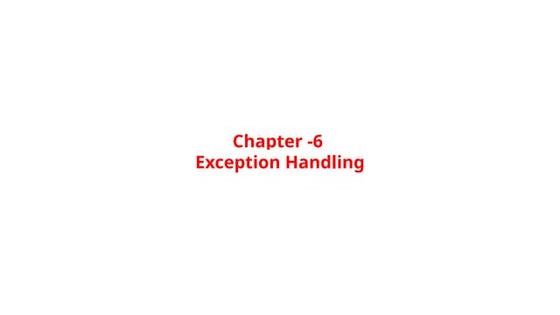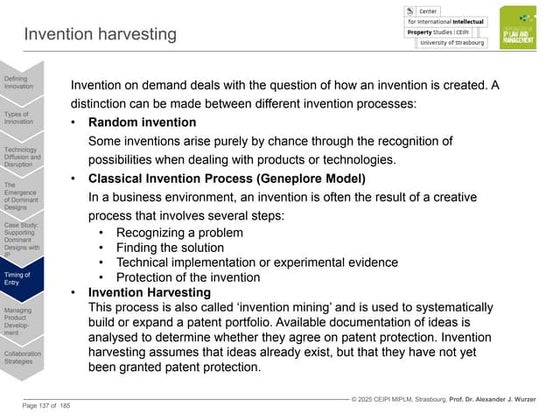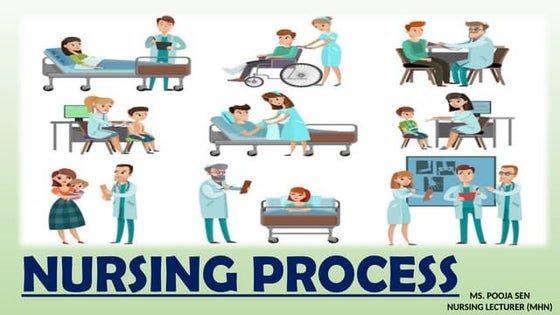Exception handling with python class 12.pptx
Download as PPTX, PDF0 likes44 views
Exception handling with python.pptx
1 of 22
Download to read offline
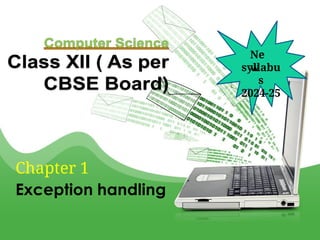

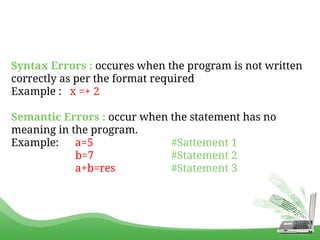


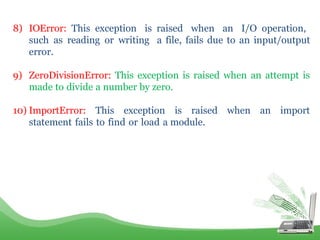

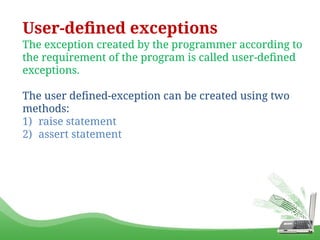
![raise statement
It is used to throw an exception. The syntax is as follows:
raise exception-name[(optional argument)]
Note: The optional argument is a string passed to the
exception, that displays the message.
Example:](https://image.slidesharecdn.com/exceptionhandling-241112043230-1b01df17/85/Exception-handling-with-python-class-12-pptx-9-320.jpg)


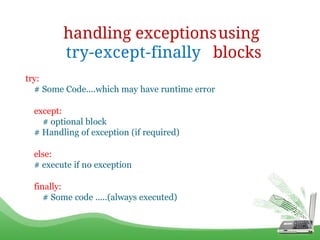
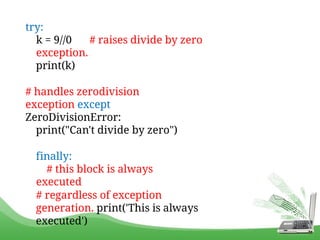




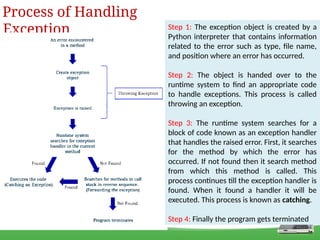


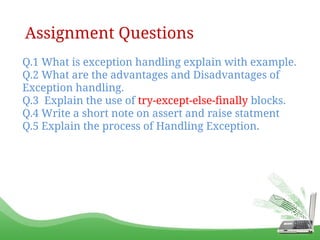
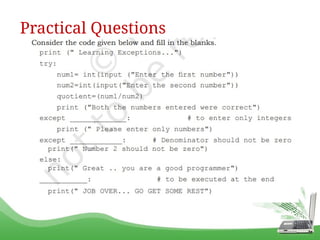
Recommended
Exception-Handling Exception-HandlingFpptx.pdf



Exception-Handling Exception-HandlingFpptx.pdfjeevithequeen2025
Ěý
Exception-HandlingException-HandlingException-HandlingException-HandlingException-HandlingException-HandlingException-HandlingException-HandlingException-HandlingException-Handling Exception-HandlingFpptx.pdf



Exception-Handling Exception-HandlingFpptx.pdfjeevithequeen2025
Ěý
Exception-HandlingException-HandlingException-HandlingException-HandlingException-HandlingException-HandlingException-HandlingException-HandlingException-HandlingExceptions overview



Exceptions overviewBharath K
Ěý
An exception is an error condition or unexpected behavior encountered during program execution. Exceptions are handled using try, catch, and finally blocks. The try block contains code that might throw an exception, the catch block handles the exception if it occurs, and the finally block contains cleanup code that always executes. Common .NET exception classes include ArgumentException, NullReferenceException, and IndexOutOfRangeException. Exceptions provide a standard way to handle runtime errors in programs and allow the programmer to define specific behavior in error cases.Exception handling



Exception handlingRaja Sekhar
Ěý
JAVA EXCEPTION HANDLING
N.V.Raja Sekhar Reddy
www.technolamp.co.in
Want more interesting...
Watch and Like us @ https://www.facebook.com/Technolamp.co.in
subscribe videos @ http://www.youtube.com/user/nvrajasekharUnit 5 Java



Unit 5 Javaarnold 7490
Ěý
The document discusses object oriented programming concepts related to exception handling in Java. It covers the benefits of exception handling such as separating error handling code from regular logic and propagating errors up the call stack. It also describes key exception handling constructs like try, catch, throw and throws. The different exception models of termination and resumption are explained along with the exception hierarchy in Java.Z blue exception



Z blue exceptionNarayana Swamy
Ěý
Exceptions represent errors that occur during program execution. The try-catch block allows exceptions to be handled gracefully. A try block contains code that might throw exceptions, while catch blocks specify how to handle specific exception types if they occur. Checked exceptions must either be caught or specified in a method's throws clause, as they represent conditions outside the programmer's control. Unchecked exceptions like NullPointerException indicate programming errors and do not require catching or specifying.Class notes(week 8) on exception handling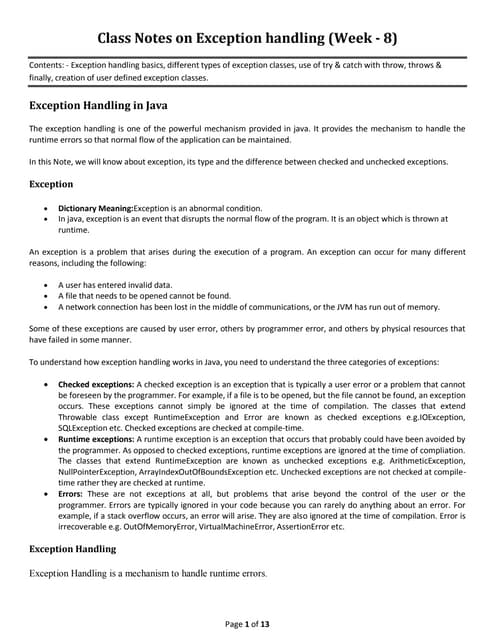



Class notes(week 8) on exception handlingKuntal Bhowmick
Ěý
java notes, object oriented programming using java, java tutorial, lecture notes, java programming notes, java example programs, java programs with explanation, java source code with output, java programs, java coding, java codes, java slides, java notes,exception handling in java, java exception handling notes, java exception handling notes,different types of exception handling in Java,exception handling with an example, exception handling in JavaPy-şÝşÝߣs-9.ppt



Py-şÝşÝߣs-9.pptwulanpermatasari27
Ěý
Python provides exception handling to deal with errors during program execution. There are several key aspects of exception handling in Python:
- try and except blocks allow code to execute normally or handle any raised exceptions. except blocks can target specific exception types or be general.
- Standard exceptions like IOError are predefined in Python. Developers can also define custom exception classes by inheriting from built-in exceptions.
- Exceptions have an optional error message or argument that provides more context about the problem. Variables in except blocks receive exception arguments.
- The raise statement intentionally triggers an exception, while finally blocks ensure code is always executed regardless of exceptions.Exception handling3.pdf



Exception handling3.pdfBrokeass1
Ěý
The document discusses exception handling in Python. It defines two types of errors: syntax errors that stop program execution, and exceptions that change normal program flow. It provides examples of different types of exceptions like SyntaxError, TypeError, and ZeroDivisionError. It explains how to handle exceptions using try-except-finally blocks and that exceptions allow for improved program reliability and easier debugging compared to syntax errors.Chapter 13 exceptional handling



Chapter 13 exceptional handlingPraveen M Jigajinni
Ěý
This document discusses exception handling in Python. It defines errors and exceptions, and describes the different types of errors like syntax errors, semantic errors, type errors, runtime errors, and logical errors. It explains how exceptions occur during program execution. The try and except blocks are described for handling exceptions, with examples given. The raise statement is explained for raising user-defined exceptions. Common built-in exceptions in Python like IOError, ImportError, ValueError and KeyboardInterrupt are also listed.Introduction to Python Prog. - Lecture 3



Introduction to Python Prog. - Lecture 3Faculty of Computers and Informatics, Suez Canal University, Ismailia, Egypt
Ěý
Introduction to Python Programming Language for absolute beginners level.Python Unit II.pptx



Python Unit II.pptxsarthakgithub
Ěý
Types of errors include syntax errors, logical errors, and runtime errors. Exceptions are errors that occur during program execution. When an exception occurs, Python generates an exception object that can be handled to avoid crashing the program. Exceptions allow errors to be handled gracefully. The try and except blocks are used to catch and handle exceptions. Python has a hierarchy of built-in exceptions like ZeroDivisionError, NameError, and IOError.Python Session - 6



Python Session - 6AnirudhaGaikwad4
Ěý
Python Errors and Built-in Exceptions
Python Exception Handling - Try,Except and Finally
Python OOP
Python Operator Overloading
Constructor
Method Overloading and Method OverridingMd07 exceptions&assertion



Md07 exceptions&assertionRakesh Madugula
Ěý
This document discusses exceptions and assertions in Java, including defining exceptions, using try/catch/finally statements, built-in exception categories, and developing programs to handle custom exceptions. It also covers appropriate uses of assertions such as validating internal invariants, control flow assumptions, and pre/postconditions. The document provides examples of throwing, catching, and propagating exceptions as well as enabling and using assertions in code.Exception handling



Exception handlingKarthik Sekar
Ěý
Exceptions are a powerful mechanism for centralized processing of errors and exceptional situations. This mechanism replaces the procedure-oriented method of error handling in which each function returns a code indicating an error or a successful execution.UNIT III (2).ppt



UNIT III (2).pptVGaneshKarthikeyan
Ěý
C++ templates and exceptions allow for more robust and reusable code. Templates allow functions and classes to work with different data types by using placeholder types that are substituted at compile-time. This avoids duplicating code and reduces errors. Exceptions provide a mechanism to handle errors and unexpected events in code through throwing and catching exception objects. Exceptions allow code to exit a block and transfer control to dedicated error handling code. Together, templates and exceptions make C++ code more flexible, reusable and fault-tolerant.UNIT III.ppt



UNIT III.pptAjit Mali
Ěý
1. The document introduces C++ templates and exceptions. It discusses function templates, class templates, and how they allow generating functions and classes for different data types.
2. It also covers exception handling in C++ using try, throw, and catch. Exceptions represent errors that require special processing. The try block encloses code that may throw exceptions, and catch blocks provide exception handlers.
3. Rethrowing exceptions allows an exception handler to pass the exception to the next enclosing try block if it cannot handle the exception itself. Exception specifications and uncaught exceptions are also discussed.Errorhandlingbyvipulkendroyavidyalayacrpfmudkhed.pptx



Errorhandlingbyvipulkendroyavidyalayacrpfmudkhed.pptxxaybhagfsus
Ěý
Take it and complete your project.Types of Exceptionsfsfsfsdfsdfdsfsfsdfsd



Types of Exceptionsfsfsfsdfsdfdsfsfsdfsdssuserce9e9d
Ěý
It explains about the fsdfsdfsdfsfsdfsdfsdfsdfsdfsdfsdfsssssssssssssssssssssssssssssssssssssssssssssssssssssssssssssssssssssssssssssssssssssssssssssssssssssssssssssssssssssssssssssssssssssssssssssssssssssssssssssssssssssssssssssssssssssssssssssssssssssssssssssssssssssss6-Error Handling.pptx



6-Error Handling.pptxamiralicomsats3
Ěý
This document summarizes a lecture on error handling and debugging in C# visual programming. It discusses using try, catch, and finally blocks to handle errors through exceptions. It also covers debugging techniques like using breakpoints to step through code. Common .NET exception classes are listed, and reasons for debugging like ensuring reliable software are provided.unit 4 msbte syallbus for sem 4 2024-2025



unit 4 msbte syallbus for sem 4 2024-2025AKSHAYBHABAD5
Ěý
The Intel 8086 microprocessor, designed by Intel in the late 1970s, is an 8-bit/16-bit microprocessor and the first member of the x86 family of microprocessors1. Here’s a brief overview of its internal architecture:
Complex Instruction Set Computer (CISC) Architecture: The 8086 microprocessor is based on a CISC architecture, which supports a wide range of instructions, many of which can perform multiple operations in a single instruction1.
Bus Interface Unit (BIU): The BIU is responsible for fetching instructions from memory and decoding them, while also managing data transfer between the microprocessor and memory or I/O devices1.
Execution Unit (EU): The EU executes the instructions1.
Memory Segmentation: The 8086 microprocessor has a segmented memory architecture, which means that memory is divided into segments that are addressed using both a segment register and an offset1.
Registers: The 8086 microprocessor has a rich set of registers, including general-purpose registers, segment registers, and special registersJava-Exception Handling Presentation. 2024



Java-Exception Handling Presentation. 2024nehakumari0xf
Ěý
Java Exception Handling Presentation is only for Educational purpose. Happy learning :)
05.02. 2024
Exception Handling In Java Presentation. 2024



Exception Handling In Java Presentation. 2024kashyapneha2809
Ěý
Exception handling in Java allows programs to handle errors and unexpected conditions gracefully. There are three main types of exceptions: checked exceptions which must be declared, unchecked exceptions which do not need to be declared, and errors which are usually unrecoverable. The try/catch block is used to catch exceptions, with catch blocks handling specific exception types. Finally blocks contain cleanup code and are always executed regardless of exceptions. Methods can declare exceptions they may throw using the throws keyword. Programmers can also create custom exception classes.Exception



Exceptionabhay singh
Ěý
The document discusses exception handling in C#. It describes how exceptions are represented by classes derived from the System.Exception class. It explains the try, catch, throw, and finally keywords used to handle exceptions. Specific exception classes like DivideByZeroException are mentioned. Examples are provided to demonstrate catching individual exceptions, catching all exceptions, and throwing exceptions manually. Finally, it discusses using finally blocks and exploring exception object properties like Message and StackTrace.Event handling



Event handlingMohamed Essam
Ěý
This document discusses exceptions in Java programming. It defines different types of errors like syntax errors, runtime errors, and logic errors. It explains the terms 'bug' and 'debugging' which originated from a moth getting stuck in a computer. It also discusses checked and unchecked exceptions in Java - checked exceptions must be declared or handled while unchecked exceptions do not need to be declared. Finally, it provides examples of common built-in exceptions in Java like NullPointerException, ArrayIndexOutOfBoundsException, and IOException.More Related Content
Similar to Exception handling with python class 12.pptx (20)
Py-şÝşÝߣs-9.ppt



Py-şÝşÝߣs-9.pptwulanpermatasari27
Ěý
Python provides exception handling to deal with errors during program execution. There are several key aspects of exception handling in Python:
- try and except blocks allow code to execute normally or handle any raised exceptions. except blocks can target specific exception types or be general.
- Standard exceptions like IOError are predefined in Python. Developers can also define custom exception classes by inheriting from built-in exceptions.
- Exceptions have an optional error message or argument that provides more context about the problem. Variables in except blocks receive exception arguments.
- The raise statement intentionally triggers an exception, while finally blocks ensure code is always executed regardless of exceptions.Exception handling3.pdf



Exception handling3.pdfBrokeass1
Ěý
The document discusses exception handling in Python. It defines two types of errors: syntax errors that stop program execution, and exceptions that change normal program flow. It provides examples of different types of exceptions like SyntaxError, TypeError, and ZeroDivisionError. It explains how to handle exceptions using try-except-finally blocks and that exceptions allow for improved program reliability and easier debugging compared to syntax errors.Chapter 13 exceptional handling



Chapter 13 exceptional handlingPraveen M Jigajinni
Ěý
This document discusses exception handling in Python. It defines errors and exceptions, and describes the different types of errors like syntax errors, semantic errors, type errors, runtime errors, and logical errors. It explains how exceptions occur during program execution. The try and except blocks are described for handling exceptions, with examples given. The raise statement is explained for raising user-defined exceptions. Common built-in exceptions in Python like IOError, ImportError, ValueError and KeyboardInterrupt are also listed.Introduction to Python Prog. - Lecture 3



Introduction to Python Prog. - Lecture 3Faculty of Computers and Informatics, Suez Canal University, Ismailia, Egypt
Ěý
Introduction to Python Programming Language for absolute beginners level.Python Unit II.pptx



Python Unit II.pptxsarthakgithub
Ěý
Types of errors include syntax errors, logical errors, and runtime errors. Exceptions are errors that occur during program execution. When an exception occurs, Python generates an exception object that can be handled to avoid crashing the program. Exceptions allow errors to be handled gracefully. The try and except blocks are used to catch and handle exceptions. Python has a hierarchy of built-in exceptions like ZeroDivisionError, NameError, and IOError.Python Session - 6



Python Session - 6AnirudhaGaikwad4
Ěý
Python Errors and Built-in Exceptions
Python Exception Handling - Try,Except and Finally
Python OOP
Python Operator Overloading
Constructor
Method Overloading and Method OverridingMd07 exceptions&assertion



Md07 exceptions&assertionRakesh Madugula
Ěý
This document discusses exceptions and assertions in Java, including defining exceptions, using try/catch/finally statements, built-in exception categories, and developing programs to handle custom exceptions. It also covers appropriate uses of assertions such as validating internal invariants, control flow assumptions, and pre/postconditions. The document provides examples of throwing, catching, and propagating exceptions as well as enabling and using assertions in code.Exception handling



Exception handlingKarthik Sekar
Ěý
Exceptions are a powerful mechanism for centralized processing of errors and exceptional situations. This mechanism replaces the procedure-oriented method of error handling in which each function returns a code indicating an error or a successful execution.UNIT III (2).ppt



UNIT III (2).pptVGaneshKarthikeyan
Ěý
C++ templates and exceptions allow for more robust and reusable code. Templates allow functions and classes to work with different data types by using placeholder types that are substituted at compile-time. This avoids duplicating code and reduces errors. Exceptions provide a mechanism to handle errors and unexpected events in code through throwing and catching exception objects. Exceptions allow code to exit a block and transfer control to dedicated error handling code. Together, templates and exceptions make C++ code more flexible, reusable and fault-tolerant.UNIT III.ppt



UNIT III.pptAjit Mali
Ěý
1. The document introduces C++ templates and exceptions. It discusses function templates, class templates, and how they allow generating functions and classes for different data types.
2. It also covers exception handling in C++ using try, throw, and catch. Exceptions represent errors that require special processing. The try block encloses code that may throw exceptions, and catch blocks provide exception handlers.
3. Rethrowing exceptions allows an exception handler to pass the exception to the next enclosing try block if it cannot handle the exception itself. Exception specifications and uncaught exceptions are also discussed.Errorhandlingbyvipulkendroyavidyalayacrpfmudkhed.pptx



Errorhandlingbyvipulkendroyavidyalayacrpfmudkhed.pptxxaybhagfsus
Ěý
Take it and complete your project.Types of Exceptionsfsfsfsdfsdfdsfsfsdfsd



Types of Exceptionsfsfsfsdfsdfdsfsfsdfsdssuserce9e9d
Ěý
It explains about the fsdfsdfsdfsfsdfsdfsdfsdfsdfsdfsdfsssssssssssssssssssssssssssssssssssssssssssssssssssssssssssssssssssssssssssssssssssssssssssssssssssssssssssssssssssssssssssssssssssssssssssssssssssssssssssssssssssssssssssssssssssssssssssssssssssssssssssssssssssssss6-Error Handling.pptx



6-Error Handling.pptxamiralicomsats3
Ěý
This document summarizes a lecture on error handling and debugging in C# visual programming. It discusses using try, catch, and finally blocks to handle errors through exceptions. It also covers debugging techniques like using breakpoints to step through code. Common .NET exception classes are listed, and reasons for debugging like ensuring reliable software are provided.unit 4 msbte syallbus for sem 4 2024-2025



unit 4 msbte syallbus for sem 4 2024-2025AKSHAYBHABAD5
Ěý
The Intel 8086 microprocessor, designed by Intel in the late 1970s, is an 8-bit/16-bit microprocessor and the first member of the x86 family of microprocessors1. Here’s a brief overview of its internal architecture:
Complex Instruction Set Computer (CISC) Architecture: The 8086 microprocessor is based on a CISC architecture, which supports a wide range of instructions, many of which can perform multiple operations in a single instruction1.
Bus Interface Unit (BIU): The BIU is responsible for fetching instructions from memory and decoding them, while also managing data transfer between the microprocessor and memory or I/O devices1.
Execution Unit (EU): The EU executes the instructions1.
Memory Segmentation: The 8086 microprocessor has a segmented memory architecture, which means that memory is divided into segments that are addressed using both a segment register and an offset1.
Registers: The 8086 microprocessor has a rich set of registers, including general-purpose registers, segment registers, and special registersJava-Exception Handling Presentation. 2024



Java-Exception Handling Presentation. 2024nehakumari0xf
Ěý
Java Exception Handling Presentation is only for Educational purpose. Happy learning :)
05.02. 2024
Exception Handling In Java Presentation. 2024



Exception Handling In Java Presentation. 2024kashyapneha2809
Ěý
Exception handling in Java allows programs to handle errors and unexpected conditions gracefully. There are three main types of exceptions: checked exceptions which must be declared, unchecked exceptions which do not need to be declared, and errors which are usually unrecoverable. The try/catch block is used to catch exceptions, with catch blocks handling specific exception types. Finally blocks contain cleanup code and are always executed regardless of exceptions. Methods can declare exceptions they may throw using the throws keyword. Programmers can also create custom exception classes.Exception



Exceptionabhay singh
Ěý
The document discusses exception handling in C#. It describes how exceptions are represented by classes derived from the System.Exception class. It explains the try, catch, throw, and finally keywords used to handle exceptions. Specific exception classes like DivideByZeroException are mentioned. Examples are provided to demonstrate catching individual exceptions, catching all exceptions, and throwing exceptions manually. Finally, it discusses using finally blocks and exploring exception object properties like Message and StackTrace.Event handling



Event handlingMohamed Essam
Ěý
This document discusses exceptions in Java programming. It defines different types of errors like syntax errors, runtime errors, and logic errors. It explains the terms 'bug' and 'debugging' which originated from a moth getting stuck in a computer. It also discusses checked and unchecked exceptions in Java - checked exceptions must be declared or handled while unchecked exceptions do not need to be declared. Finally, it provides examples of common built-in exceptions in Java like NullPointerException, ArrayIndexOutOfBoundsException, and IOException.More from PreeTVithule1 (7)
Data Base Management 1 Database Management.pptx



Data Base Management 1 Database Management.pptxPreeTVithule1
Ěý
Data Base Management 1 Database Management.pptxNetwork and network types6 class 12 computer.ppt



Network and network types6 class 12 computer.pptPreeTVithule1
Ěý
Network and network types6 class 12.ppt7-2-data-structures-ii-stacks-queues.pptx



7-2-data-structures-ii-stacks-queues.pptxPreeTVithule1
Ěý
Stacks and queues are linear data structures. Stacks follow LIFO (last in first out) where elements can only be inserted or removed from one end called the top. Queues follow FIFO (first in first out) where elements are removed from the front and added to the back. Stacks have operations like push, pop and peek while queues have enqueue, dequeue and peek. Both can be implemented in Python using built-in list methods and are useful for applications like reversing strings, solving math expressions and more.Recently uploaded (20)
How to Setup Company Data in Odoo 17 Accounting App



How to Setup Company Data in Odoo 17 Accounting AppCeline George
Ěý
The Accounting module in Odoo 17 is a comprehensive tool designed to manage all financial aspects of a business. It provides a range of features that help with everything from day-to-day bookkeeping to advanced financial analysis. Design approaches and ethical challenges in Artificial Intelligence tools for...



Design approaches and ethical challenges in Artificial Intelligence tools for...Yannis
Ěý
The recent technology of Generative Artificial Intelligence (GenAI) has undeniable advantages, especially with regard to improving the efficiency of all stakeholders in the education process.
At the same time, almost all responsible international organisations and experts in the field of education and educational technology point out a multitude of general ethical problems that need to be addressed. Many of these problems have already arisen in previous models of artificial intelligence or even in systems based on learning data, and several are appearing for the first time.
In this short contribution, we will briefly review some dimensions of ethical problems, both (a) the general ones related to trust, transparency, privacy, personal data security, accountability, environmental responsibility, bias, power imbalance, etc., and (b) the more directly related to teaching, learning, and education, such as students' critical thinking, the social role of education, the development of teachers' professional competences, etc.
In addition, the categorizations of possible service allocation to humans and AI tools, the human-centered approach to designing AI tools and learning data, as well as the more general design of ethics-aware applications and activities will be briefly presented. Finally, some short illustrative examples will be presented to set the basis for the debate in relation to ethical and other dilemmas.Anti-Fungal Agents.pptx Medicinal Chemistry III B. Pharm Sem VI



Anti-Fungal Agents.pptx Medicinal Chemistry III B. Pharm Sem VISamruddhi Khonde
Ěý
UNIT – IV
Antifungal agents:
Antifungal antibiotics: Amphotericin-B, Nystatin, Natamycin, Griseofulvin.
Synthetic Antifungal agents: Clotrimazole, Econazole, Butoconazole,
Oxiconazole Tioconozole, Miconazole*, Ketoconazole, Terconazole,
Itraconazole, Fluconazole, Naftifine hydrochloride, Tolnaftate*Sulfonamides by Mrs. Manjushri P. Dabhade



Sulfonamides by Mrs. Manjushri P. DabhadeDabhade madam Dabhade
Ěý
Describe the information about classification, mechanism of action and chemical structures of sulfonamidesQuizzitch Cup_Sports Quiz 2025_Prelims.pptx



Quizzitch Cup_Sports Quiz 2025_Prelims.pptxAnand Kumar
Ěý
Relive the excitement of the Sports Quiz conducted as part of the prestigious Quizzitch Cup 2025 at NIT Durgapur! Organized by QuizINC, the official quizzing club, this quiz challenged students with some of the most thrilling and thought-provoking sports trivia.
📌 What’s Inside?
✅ A diverse mix of questions across multiple sports – Cricket, Football, Olympics, Formula 1, Tennis, and more!
âś… Challenging and unique trivia from historic moments to recent sporting events
âś… Engaging visuals and fact-based questions to test your sports knowledge
âś… Designed for sports enthusiasts, quiz lovers, and competitive minds
Students, sports fans, and quizzers looking for an exciting challenge
College quizzing clubs and organizers seeking inspiration for their own sports quizzes
Trivia buffs and general knowledge enthusiasts who love sports-related facts
Quizzing is more than just answering questions—it’s about learning, strategizing, and competing. This quiz was crafted to challenge even the sharpest minds and celebrate the world of sports with intellect and passion!CLEFT LIP AND PALATE: NURSING MANAGEMENT.pptx



CLEFT LIP AND PALATE: NURSING MANAGEMENT.pptxPRADEEP ABOTHU
Ěý
Cleft lip, also known as cheiloschisis, is a congenital deformity characterized by a split or opening in the upper lip due to the failure of fusion of the maxillary processes. Cleft lip can be unilateral or bilateral and may occur along with cleft palate. Cleft palate, also known as palatoschisis, is a congenital condition characterized by an opening in the roof of the mouth caused by the failure of fusion of the palatine processes. This condition can involve the hard palate, soft palate, or both.Antifungal agents by Mrs. Manjushri Dabhade



Antifungal agents by Mrs. Manjushri DabhadeDabhade madam Dabhade
Ěý
Information about chemical structure, MOA, ClassificationGeneral Quiz at ChakraView 2025 | Amlan Sarkar | Ashoka Univeristy | Prelims ...



General Quiz at ChakraView 2025 | Amlan Sarkar | Ashoka Univeristy | Prelims ...Amlan Sarkar
Ěý
Prelims (with answers) + Finals of a general quiz originally conducted on 9th February, 2025.
This was the closing quiz of the 2025 edition of ChakraView - the annual quiz fest of Ashoka University.
Feedback welcome at amlansarkr@gmail.com How to Install Odoo 18 with Pycharm - Odoo 18 şÝşÝߣs



How to Install Odoo 18 with Pycharm - Odoo 18 şÝşÝߣsCeline George
Ěý
In this slide we’ll discuss the installation of odoo 18 with pycharm. Odoo 18 is a powerful business management software known for its enhanced features and ability to streamline operations. Built with Python 3.10+ for the backend and PostgreSQL as its database, it provides a reliable and efficient system. Berry_Kanisha_BAS_PB1_202503 (2) (2).pdf



Berry_Kanisha_BAS_PB1_202503 (2) (2).pdfKanishaBerry
Ěý
Kanisha Berry's Full Sail University Personal Branding Exploration Assignment Studying and Notetaking: Some Suggestions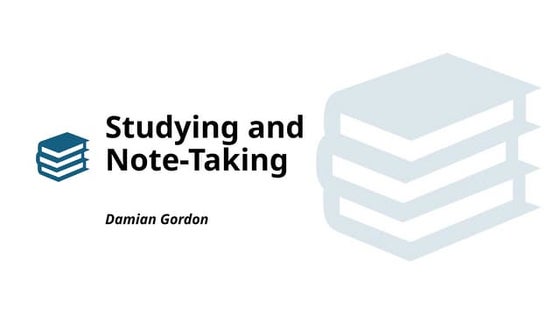



Studying and Notetaking: Some SuggestionsDamian T. Gordon
Ěý
Studying and Notetaking: Some SuggestionsIntroduction to Systematic Reviews - Prof Ejaz Khan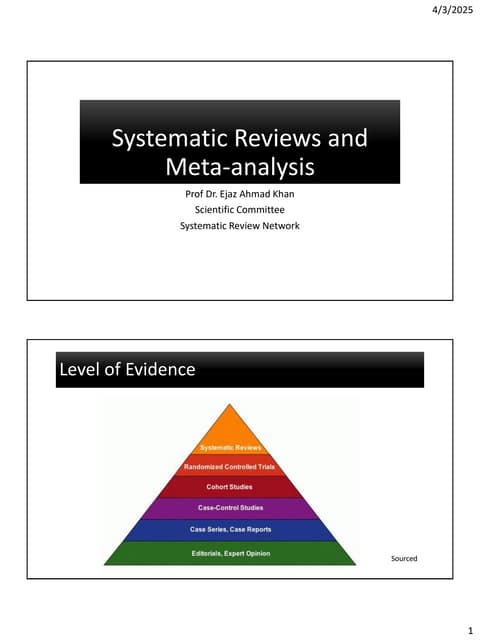



Introduction to Systematic Reviews - Prof Ejaz KhanSystematic Reviews Network (SRN)
Ěý
A Systematic Review:
Provides a clear and transparent process
• Facilitates efficient integration of information for rational decision
making
• Demonstrates where the effects of health care are consistent and
where they do vary
• Minimizes bias (systematic errors) and reduce chance effects
• Can be readily updated, as needed.
• Meta-analysis can provide more precise estimates than individual
studies
• Allows decisions based on evidence , whole of it and not partialException handling with python class 12.pptx
- 2. Exception Handling As a student of computer science, you know that many times while executing the program we are getting some errors. Errors are problems in a program due to which will stop the program from execution. These errors are categorized as follows:
- 3. Syntax Errors : occures when the program is not written correctly as per the format required Example : x =+ 2 Semantic Errors : occur when the statement has no meaning in the program. Example: a=5 #Sattement 1 b=7 #Statement 2 a+b=res #Statement 3
- 4. Exceptions An exception is a program event that occurs during program execution and disrupts the flow of a program. When a python program cannot Handle with a situation, it raises an exception. An exception is a Python object that represents an error. Some common Python Build-in exceptions are as follows: 1) SyntaxError: This exception is raised when the interpreter encounters a syntax error the code, such as a misspelled keyword, a missing colon, or an unbalanced parenthesis. 2) TypeError: This exception is raised when an operation or function is applied to an object of the wrong type, such as adding a string to an integer.
- 5. 3) NameError: This exception is raised when a variable or function name is not found in the current scope. 4) IndexError: This exception is raised when an index is out of range for a list, tuple, or other sequence types. 5) KeyError: This exception is raised when a key is not found in a dictionary. 6) ValueError: This exception is raised when a function or method is called with an invalid argument or input, such as trying to convert a string to an integer when the string does not represent a valid integer. 7) AttributeError: This exception is raised when an attribute or method is not found on an object, such as trying to access a non- existent attribute of a class instance.
- 6. 8) IOError: This exception is raised when an I/O operation, such as reading or writing a file, fails due to an input/output error. 9) ZeroDivisionError: This exception is raised when an attempt is made to divide a number by zero. 10) ImportError: This exception is raised when an import statement fails to find or load a module.
- 7. Raising Exceptions Exceptions are raised when the program is syntactically correct, but the code results in an error. This error does not stop the execution of the program, however, it changes the normal flow of the program. Example: a = 10 / 0 print(a)
- 8. User-defined exceptions The exception created by the programmer according to the requirement of the program is called user-defined exceptions. The user defined-exception can be created using two methods: 1) raise statement 2) assert statement
- 9. raise statement It is used to throw an exception. The syntax is as follows: raise exception-name[(optional argument)] Note: The optional argument is a string passed to the exception, that displays the message. Example:
- 10. assert statement An assert statement is used to check a condition in the program code. If the result after evaluation is false, then the exception is raised. The syntax for the assert statement is: If this expression is false, an AssertionError exception is raised which can be handled like any other exception. Example:
- 11. What is Exception Handling in Python The process of catching and preventing errors when they occurred is called exception handling. It is a mechanism to overrule the exceptions using some blocks. It is the concept of error handling when something goes wrong, tracking the error, and calling the handling code. The following terms are used for exception handling:
- 12. handling exceptionsusing try-except-finally blocks try: # Some Code....which may have runtime error except: # optional block # Handling of exception (if required) else: # execute if no exception finally: # Some code .....(always executed)
- 13. try: k = 9//0 # raises divide by zero exception. print(k) # handles zerodivision exception except ZeroDivisionError: print("Can't divide by zero") finally: # this block is always executed # regardless of exception generation. print('This is always executed')
- 14. Lets see some example’s for better understanding of Try and Except block
- 15. Use of try and except
- 18. Process of Handling Exception Step 1: The exception object is created by a Python interpreter that contains information related to the error such as type, file name, and position where an error has occurred. Step 2: The object is handed over to the runtime system to find an appropriate code to handle exceptions. This process is called throwing an exception. Step 3: The runtime system searches for a block of code known as an exception handler that handles the raised error. First, it searches for the method by which the error has occurred. If not found then it search method from which this method is called. This process continues till the exception handler is found. When it found a handler it will be executed. This process is known as catching. Step 4: Finally the program gets terminated
- 19. Advantages of Exception Handling: • Improved program reliability • Simplified error handling • Cleaner code • Easier debugging Disadvantages of Exception Handling: • Performance overhead • Increased code complexity • Possible security risks
- 20. Thank You Any doubts ?
- 21. Assignment Questions Q.1 What is exception handling explain with example. Q.2 What are the advantages and Disadvantages of Exception handling. Q.3 Explain the use of try-except-else-finally blocks. Q.4 Write a short note on assert and raise statment Q.5 Explain the process of Handling Exception.
